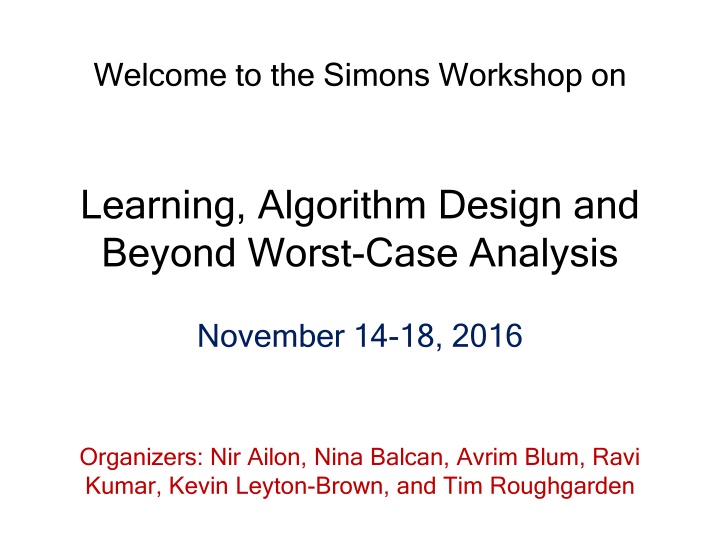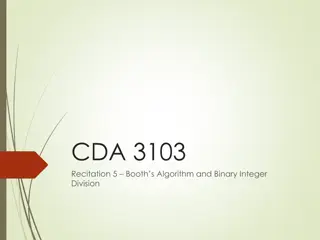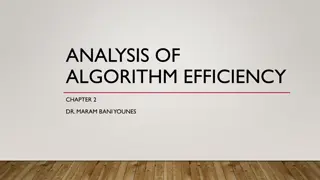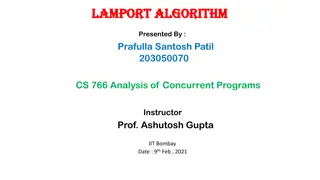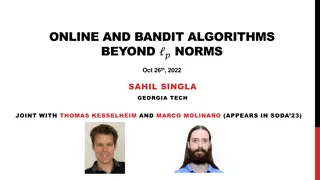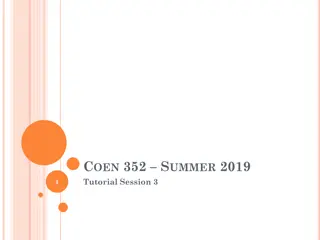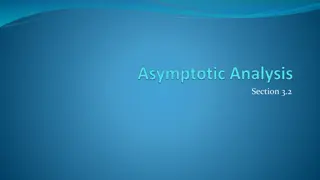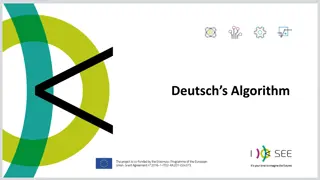Simons Workshop on Learning and Algorithm Design: Beyond Worst-Case Analysis
Simons Workshop on Learning, Algorithm Design, and Beyond Worst-Case Analysis in 2016 featured top organizers and discussed algorithm analysis, instance structures, worst-case scenarios, average-case analysis, and more. The workshop included social events and informative talks.
Download Presentation

Please find below an Image/Link to download the presentation.
The content on the website is provided AS IS for your information and personal use only. It may not be sold, licensed, or shared on other websites without obtaining consent from the author.If you encounter any issues during the download, it is possible that the publisher has removed the file from their server.
You are allowed to download the files provided on this website for personal or commercial use, subject to the condition that they are used lawfully. All files are the property of their respective owners.
The content on the website is provided AS IS for your information and personal use only. It may not be sold, licensed, or shared on other websites without obtaining consent from the author.
E N D
Presentation Transcript
Welcome to the Simons Workshop on Learning, Algorithm Design and Beyond Worst-Case Analysis November 14-18, 2016 Organizers: Nir Ailon, Nina Balcan, Avrim Blum, Ravi Kumar, Kevin Leyton-Brown, and Tim Roughgarden
This workshop on Learning, Algorithm Design and Beyond Worst-Case Analysis is part of the Semester Program on Algorithms and Uncertainty (Fall 2016) at the Simons Institute for the Theory of Computing
Some notes: No food/drinks in auditorium (sorry) Wireless: CalVisitor or eduroam Time for short impromptu talks (email/talk to me) Reception after the talks today Optional social events each evenings: Mon: microbrew pub Tue: game night Wed: trip to SF Thu: microbrew pub Fri: Vik s Chaat House
A Brief Tour of Algorithm Analysis Beyond the Worst Case Avrim Blum Carnegie Mellon University
Whats the issue? A problem (like network flow, TSP, graph coloring, SAT, clustering, ) consists of a family of instances Traditional goal in TCS: algorithm that performs well on all instances in the family, i.e., Worst-Case Analysis Great if we can do it
Worst-Case Analysis Don t need to worry about instance structure, can use for reductions (e.g., network flow, LP), etc. We feel we have cracked the problem if we have an alg that does well on all instances in the family. Great if we can do it
Worst-Case Analysis Don t need to worry about instance structure, can use for reductions (e.g., network flow, LP), etc. We feel we have cracked the problem if we have an alg that does well on all instances in the family. But what if we can t?
Average-Case Analysis Look at random instances Less pessimistic Can often give some insight into the problem Worst case Average case [Beardwood et al 1959]: tight analysis of length of optimal TSP tour for random points in unit square [Karp 1977]: asymptotically optimal heuristic for avg case
Average-Case Analysis Look at random instances On the other hand, random typical (e.g., images) vs Also random instances often very specific E.g., random 3-colorable graph Two nodes of same color share 2? neighbors in common Two nodes of different color share ? neighbors in common 3?2 3?2
1990s: Intermediate models Issue of worst-case (great if you can do well but for many problems you can t) vs average case (random typical) led to flurry of work in 1990s on intermediate models Average Case Worst Case Focus: NP-hard problems that are hard to approximate well in worst-case, online problems with high competitive ratios
Semi-random input model [FOCS 1990]
Semi-random input model [Feige-Kilian 98] Algs for ?-coloring, independent set in semi-random model for very low ( best possible) noise rate ?. Make model more adversarial: Noise only adds edges Adversary can see all coin flips in advance I.e., start with sparse random graph (between colors or from ? to ?) and adversary adds to it Bisection: stochastic block model + monotone changes See Aravindan s talk for recent results in graph partitioning See Uri s talk for model where randomness replaced with expansion
On-line algorithms Algorithm faced with request sequence ?. Must make decisions without knowing future. ???????? ???????? Competitive ratio: max ? Paging: Best possible deterministic ratio is ?, achieved by both good algorithms (LRU) and bad algorithms (FIFO, ) Explain what makes LRU good? Bypass this lower bound?
On-line algorithms Access-graph model [Borodin-Irani-Raghavan-Schieber 91] Program graph ? on pages. Accesses restricted to walks on this graph Analyze competitive ratio of LRU as a function of the graph LRU never much worse than FIFO and can be much better, and design interesting near-optimal algorithm
On-line algorithms Access-graph model [Borodin-Irani-Raghavan-Schieber 91] Loose-competitiveness model [Young 91] For any request sequence, for almost all ?, ratio ... (or cost is small in absolute terms) Markov-paging model [Karlin-Phillips-Raghavan 92] Diffuse-adversary model [Koutsoupias-Papadimitriou 94] Request sequence drawn from distribution D belonging to known class of distributions
1990s Learning theory Combining expert advice [Littlestone-Warmuth] [Cesa- Bianchi et al] Given a collection of actions (which way to drive to work today), which one should you take? Robots R Us 32 min In hindsight, should have followed path A on day 1, path B on day 2, path A on day 3, Just try to compete with best single action (path). Motivationally, if world was iid, best strategy would be a single action (Model is worst-case, but competing wrt best strategy in class that includes optimal for iid setting)
2000s: Understand observed success Smoothed analysis model [Spielman-Teng 01] Every entry perturbed with small Gaussian noise Simplex Algorithm for LP runs in poly expected time: max ? = ????(?) ??? ? + ? More adversarial than semi-random model
2000s: Understand observed success Smoothed analysis model [Spielman-Teng 01] 2-OPT TSP heuristic [Englert-R glin-V cking 07] Lloyd s ?-means algorithm [Arthur-Manthey-R glin 09] (analysis is for time to reach a local optimum)
Late 2000s+: models of nice inputs Replace randomness with deterministic conditions. Goals: Understand reasonable inputs What properties of an instance make it easy/hard to find a global optimum or desired solution? Can we use implicit assumptions in formulations? Explain success of common heuristics
Late 2000s+: models of nice inputs ?-means clustering [Ostrovsky-Rabani-Schulman-Swamy 06] Cost of optimal ?-means clustering decreases with ?. Often choose ?based on knee in the curve. x x x x x x x If ???? ?2???? 1 then natural heuristic finds 1 + ? ????. If ???? (1 ?)???? 1 for constant ? > 0, can get PTAS. [Awasthi-B-Sheffet 10]
Late 2000s+: models of nice inputs Approximation Stability [Balcan-B-Gupta 09] Perturbation Resilience [Bilu-Linial 10] Idea: identify assumptions that (a) are natural based on how input was collected, or (b) we will want to assume anyway because of how the output is being used. Observation: In many problems, true goal is to match a reference/ground-truth/desired solution. Objective just a proxy.
Late 2000s+: models of nice inputs Given a set of news articles, cluster them how a user would. Given a set of images, cluster by who is in them. Given a picture, correctly segment into objects. Observation: In many problems, true goal is to match a reference/ground-truth/desired solution. Objective just a proxy.
Late 2000s+: models of nice inputs Here, the objective function (like ?-means score) is a measurable proxy for an unmeasurable goal of accuracy. Obviously yes if one has a c-approx alg, but what if you don t? [Balcan-B-Gupta 09] (?,?)-Approximation Stability: Suppose that all ?-approx s to are ?-close to reference solution. Can one use this to get ?(?) close? ? OPT OPT Desired solution
Approximation-Stability [Balcan-B-Gupta 09]: for ?-median, ?-means, min-sum clustering, answer is yes even for ? = 1.1. [Voevodski-Balcan-Roglin-Teng-Xia 10]: superfast algos (small number of distance queries) with this guarantee. Apply to biological sequence clustering. [Awasthi-Balcan-B-Sheffet-Vempala 10]: Nash equilibria ? OPT OPT Desired solution
Perturbation-Resilience [Bilu-Linial 10] Choice of edge weights, locations often somewhat heuristic If small changes to the input affected the optimal solution a lot, then if OPT is good (close to the desired solution) it s just by luck
Perturbation-Resilience [Bilu-Linial 10] Choice of edge weights, locations often somewhat heuristic Input is ?-perturbation resilient if changing input values by a factor ?doesn t change optimal solution (at all).
Perturbation-Resilience [Bilu-Linial 10] Generally harder than approximation-stability for the same level of parameter. While an optimal solution in a perturbed instance is also an approx-optimal solution in the original, the other direction need not be true. Many/most results need stability above approx bound In some cases (Nash equilibria) the two notions coincide [Balcan-Braverman 10]
Perturbation-Resilience [Bilu-Linial 10] Lots of results on: Max-cut [Bilu-Linial 10] [Bilu-Daniely-Linial-Saks 13] [Makarychev- Makarychev-Vijayaraghavan 14] Nash equilibria [Balcan-Braverman 10] TSP [Mihalak-Schongens-Sramek-Widmayer 11] ?-median/means [Awasthi-B-Sheffet 12] [Balcan-Liang 12] [Makarychev-Makarychev 16] ?-center (incl asymmetric) [Balcan-Haghtalab-White 16] Talk today Minimum multiway cut [Makarychev-Makarychev-Vijayaraghavan 14] Related: [Kushagra-Samadi-BenDavid 16] [Ashtiani-Kushagra-BenDavid 16]
Average-case for Unknown Distribution Concern with usual average-case analysis: random typical vs How about average-case over the distribution of typical instances for your given application? Input is a collection of random samples of instances from your application Then try to use them to learn the best algorithm (from some given family) for your application s distribution
Average-case for Typical Examples Sorting and problems in computational geometry [Ailon- Chazelle-Clarkson-Liu-Mulzer-Seshadhri 11] Assume product distribution on items within input, compete with information-theoretic optimum Revenue-maximizing auctions [Elkind 07] [Cole-Roughgarden 14] [Morgenstern-Roughgarden 15] [Devanur-Huang-Psamos 16], General algorithmic problems [Gupta-Roughgarden 16] [Balcan-Nagarajan-Vitercik-White 16] No prior assumption on distribution of instances Compete with best algorithm from a given natural family A Will see talks on these this week
Coming Up Theoretical talks on algorithms and models Empirical talks on approaches in practice/experiments Application talks on properties of real-world inputs in various domains Enjoy!
